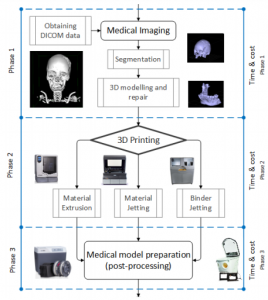
In the study, the researchers used CT images to 3D model and print a human skull and jawbone. They created several copies, using multiple methods of 3D printing including material extrusion, binder jetting and material jetting processes. The researchers describe in detail the processes they used to obtain the images for the models and to render them in 3D. The process is divided into three phases: imaging, 3D printing and medical model preparation or post-processing. Each phase has several subphases that add time and cost to the entire process.
First the DICOM data was obtained from an OsiriX DICOM sample image set, then imported to OsiriX MD 8.0.2 and segmented using 500 Hounsfield unit (HU) to add bone and more dense materials to the 3D model. The 3D file was exported in STL format to obtain the jaw and skull geometry.
“The STL file was first imported to DeskArtes 3D Data Export 10.3,” the researchers explain. “The shells were verified to separate volumes, which are not in contact with each other. The other shells except the jaw and skull were then removed. The models were repaired using automatic repairing tools. The jaw model was then ready and exported as a separate STL…file. The skull model required one more repairing round by first removing all error triangles and triangles next to the error triangles and further running an automatic repairing for a second time. The skull models were also exported as a separate STL file. After that both models were repaired and ready for the 3D-printing phase.”
For the material extrusion, also known as FDM or FFF 3D printing, the researchers used a Stratasys uPrint SE Plus, ABS Plus filament, and SR-30 Solubule Support Material. For material jetting, they used a Stratasys Objet30 Scholar 3D printer with Verowhite material and SUP705 support material. For binder jetting, they used a Zprinter 450 from 3D Systems, with ZP151 material.
“Costs of 3D printing will be reduced in the future as the technology and the used materials will be further developed,” the researchers conclude. “More importantly, this will subsequently create new applications areas. Even quite high costs for 3D-printed medical models can be acceptable if their use will save time in operation and lead to better operation outcomes.”
Authors of the paper include Mika Salmi, Inigo Flores Ituarte, Jukka Tuomi, and Antti Mäkitie.
Discuss this and other 3D printing topics at 3DPrintBoard.com or share your thoughts below.